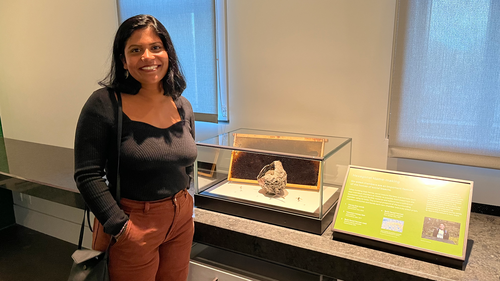
Daphne Klemme, senior administrative assistant in physics, interviewed Yale Physics graduate student Joy Pajarla about her curation of an exhibit at the Yale Peabody Museum about biological patterning called “Hexagonal Home-Making,” on permanent display in the Dynamic Nature section on the third floor of the museum. The transcript of the conversation follows below:
Please tell me about the project and how it came about.
The origin of this project was actually very serendipitous! I met Kailen Rogers, the associate director of exhibitions at the Peabody at the dog park near my old apartment during my first year as a grad student. From the hydrodynamic flow of water over fish of various sizes to the swarming patterns of birds to the remarkable cooperativity of social insects, each week, while watching our dogs play, we would discuss the physics of a different natural system. It felt especially exciting and valuable while in the throes of brutal course work to identify and appreciate the physics that drives the world around me in a more relaxed setting. In those conversations, I truly felt like a physicist. At this time, Kailen was mapping out the exhibits for the Peabody renovation and thought it would be interesting to get a physicist’s perspective on the natural sciences exhibits. So, she offered me a position as a museum curatorial assistant.
 Tell me a little about yourself and why this project appealed to you.
Tell me a little about yourself and why this project appealed to you.
I spend a lot of my free time thinking and learning as much as I can about my favorite insect and plant systems and discussing my observations with anyone who wants to listen. My graduate school classes and projects have given me the language to not only discuss but also to systematically investigate my favorite natural phenomena. Research has its highs and lows, but, for me, finding creative and compelling ways to communicate my interests to people of non-academic and academic backgrounds has always been rewarding. This project was one way to contribute my expertise to the broader New Haven community. I want people, especially kids, to see the complexity and elegance of the natural world and to be inspired to study and conserve it.
How does this project fit in with your educational goals, etc.?
I came to graduate school to study the relationship between pattern formation and energy efficiency. Though this reciprocity is prevalent in both living and non-living systems, I think nature does a good job of capturing how dynamic this connection really is. Living systems are always strategically walking the line between local order and global disorder. I think this is fascinating not only in and of itself but also in how it can inform the ecology of human and non-human living being interactions. In the future, I see myself combining my research and science communication backgrounds to bring attention to this broader relationship.
See below for link to original X (Twitter) post from the Yale Program in Physical and Engineering Biology (PEB) and click here for the flickr album of images submitted by Joy Pajarla for this story.